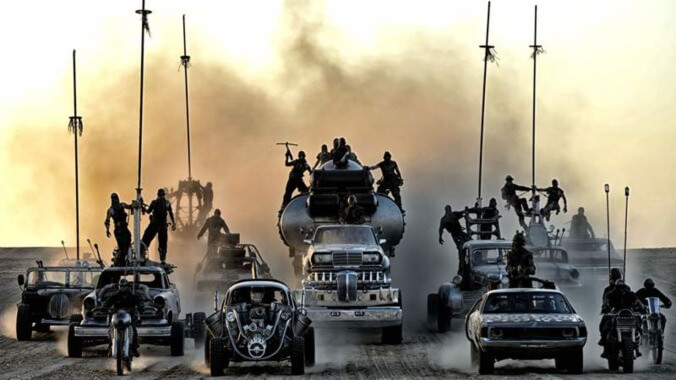Charlize Theron, Tom Hardy remember the hell of making Mad Max: Fury Road in new oral history

The grimy, windblown thrills of 2015's Mad Max: Fury Road won’t be forgotten any time soon. George Miller’s epic, decade-in-the-works sequel topped several Best of 2010s lists late last year—including ours—and, years later, continues to prompt cries for a sequel. Based on the hellish tales told in this New York Times new oral history of the film, however, we’re not holding our breath.
The actors interviewed for the piece—Charlize Theron, Tom Hardy, Zoe Kravitz, Riley Keogh, and more—each document the exhaustion of the film’s unending shoot, though each clearly cherishes the experience. “It left me irrevocably changed,” says Hardy. “It was one of the wildest, most intense experiences of my life,” Keogh echoes.
“Like anything that has some worth to it, it comes with complicated feelings,” says Theron. “I feel a mixture of extreme joy that we achieved what we did, and I also get a little bit of a hole in my stomach. There’s a level of ‘the body remembers’ trauma related to the shooting of this film that’s still there for me.”
Part of that has to do with the well-publicized tension that existed between her, Miller, and Hardy on set, which is unpacked here with some added detail and context. “Tom really had moments of frustration, of anger,” Kravitz recalls. “Charlize did, too, but I feel like he’s the one who really took it out on George the most, and that was a bummer to see. But you know, in some ways, you also can’t blame him, because a lot was being asked of these actors and there were a lot of unanswered questions.”
Hardy adds, “Because of how much detail we were having to process and how little control one had in each new situation, and how fast the takes were—tiny snippets of story moments were needed to make the final cut work—we moved fast, and it was at times overwhelming.” Hardy goes on to say he was “in over [his] head in many ways,” saying that Theron needed “a better, perhaps more experienced, partner in me.”
Theron is gracious towards Hardy, however. “In retrospect, I didn’t have enough empathy to really, truly understand what he must have felt like to step into Mel Gibson’s shoes,” he says. “That is frightening! And I think because of my own fear, we were putting up walls to protect ourselves instead of saying to each other, ‘This is scary for you, and it’s scary for me, too. Let’s be nice to each other.’ In a weird way, we were functioning like our characters: Everything was about survival.”
There’s plenty of fascinating bits elsewhere in the piece. The Vagina Monologues author, Eve Ensler, for example, was brought in to help shape the film’s portrait of abused women and work with the actors. Also of note is producer Doug Mitchell’s harrowing story of how Miller was forced by Warner Bros.’ Jeff Robinov to wrap filming before he and his crew could film the opening and closing scenes at the Citadel. It was only when Kevin Tsujihara took over for Robinov as the studio’s head that Miller was given an additional month to tie everything up.
Miller, meanwhile, is succinct in articulating his frustration with the higher-ups: “When someone is directing a film, they’re thinking about it every waking hour, and even processing it in their dreams. The problem is, if you’re a studio executive, you tend to think about it for 10 minutes on a Wednesday.”
Read the full oral history, which encompasses 20 of the film’s key players, in full here.
Send Great Job, Internet tips to [email protected]